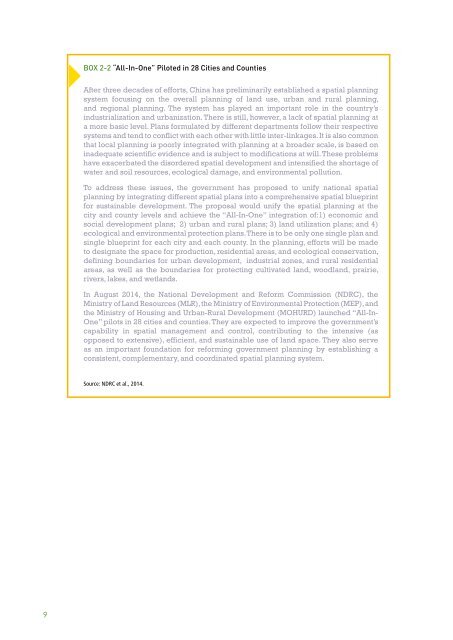GREEN IS GOLD
greenisgold_en_20160519
greenisgold_en_20160519
Create successful ePaper yourself
Turn your PDF publications into a flip-book with our unique Google optimized e-Paper software.
Box 2-2 “All-In-One” Piloted in 28 Cities and Counties<br />
After three decades of efforts, China has preliminarily established a spatial planning<br />
system focusing on the overall planning of land use, urban and rural planning,<br />
and regional planning. The system has played an important role in the country’s<br />
industrialization and urbanization. There is still, however, a lack of spatial planning at<br />
a more basic level. Plans formulated by different departments follow their respective<br />
systems and tend to conflict with each other with little inter-linkages. It is also common<br />
that local planning is poorly integrated with planning at a broader scale, is based on<br />
inadequate scientific evidence and is subject to modifications at will. These problems<br />
have exacerbated the disordered spatial development and intensified the shortage of<br />
water and soil resources, ecological damage, and environmental pollution.<br />
To address these issues, the government has proposed to unify national spatial<br />
planning by integrating different spatial plans into a comprehensive spatial blueprint<br />
for sustainable development. The proposal would unify the spatial planning at the<br />
city and county levels and achieve the “All-In-One” integration of:1) economic and<br />
social development plans; 2) urban and rural plans; 3) land utilization plans; and 4)<br />
ecological and environmental protection plans. There is to be only one single plan and<br />
single blueprint for each city and each county. In the planning, efforts will be made<br />
to designate the space for production, residential areas, and ecological conservation,<br />
defining boundaries for urban development, industrial zones, and rural residential<br />
areas, as well as the boundaries for protecting cultivated land, woodland, prairie,<br />
rivers, lakes, and wetlands.<br />
In August 2014, the National Development and Reform Commission (NDRC), the<br />
Ministry of Land Resources (MLR), the Ministry of Environmental Protection (MEP), and<br />
the Ministry of Housing and Urban-Rural Development (MOHURD) launched “All-In-<br />
One” pilots in 28 cities and counties. They are expected to improve the government’s<br />
capability in spatial management and control, contributing to the intensive (as<br />
opposed to extensive), efficient, and sustainable use of land space. They also serve<br />
as an important foundation for reforming government planning by establishing a<br />
consistent, complementary, and coordinated spatial planning system.<br />
Source: NDRC et al., 2014.<br />
9


